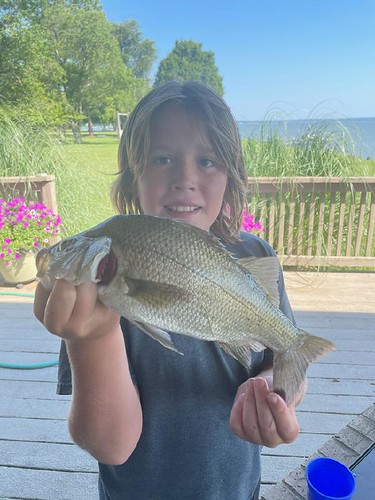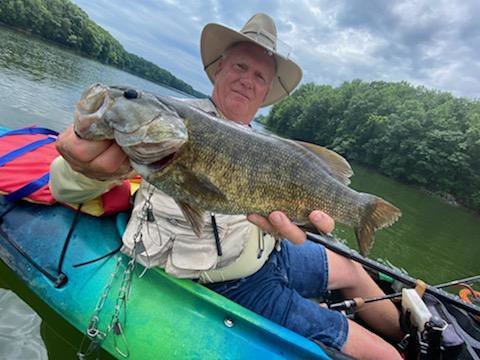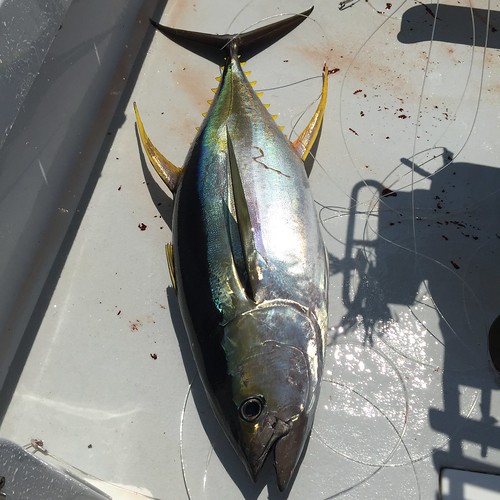Maryland Fishing Report – July 20

Photo by Bob Bruns
Chesapeake Bay anglers received a welcome surprise this week with the arrival of wonderful numbers of speckled trout, bluefish, and spot. These offer great alternatives during the striped bass closure in the Chesapeake Bay through July 31 and the tidal Potomac River until August 21.
Elsewhere, the waters off Ocean City are offering excellent fishing for a mix of species including black sea bass, tuna, and white marlin. There is also plenty of great fishing throughout Maryland waters for freshwater anglers.
The Maryland Department of Natural Resources is always looking to encourage more Marylanders to take up the exciting sport of fishing. DNR invites college students and adults aged 18 and older to free mentored fishing training and practice sessions in August. The program will comprise four sessions in various locations in Anne Arundel and Prince George’s counties, culminating with a fishing tournament on August 13. Space is limited – check the DNR website for details.
Forecast Summary: July 20 – July 26:
Sunny, warm, and relatively calm weather continues, with chances of thunderstorms on Sunday through Tuesday. Mid-July water temperatures typically are the warmest of the year. Chesapeake Bay surface water temperatures have risen to the low to mid-80s, and Maryland rivers are running in the mid to upper 70s. Expect continued warming as the week progresses. If you are seeking areas with cooler waters, fish the surface early in the day, or fish deeper waters or upwind areas.
At the following locations, adequate oxygen conditions can be found from the surface down to these depth ranges: from the Virginia state line up to the Gooses Reef buoy, 25 feet to the bottom; Little Choptank up to the Choptank River, 30 feet to bottom, and 10 feet on the western shore; Bloody Point, 10 feet to 30 feet; Bay Bridge, 10 feet to 30 feet; Swan Point, 30 feet; and Still Pond up to the Susquehanna Flats, surface to bottom. Poor deep water oxygen conditions are present in most tributaries, where there is adequate oxygen down to about 20 feet. On the Potomac River, there is adequate oxygen down to 15 feet from the 301 Bridge down to the St. Mary’s River. It is likely that in most locations, gamefish will be deeper in the water column to find adequate oxygen and their preferred water temperatures. In addition, if you are seeking areas with cooler waters in your area, fish surface waters early in the day, or find deeper waters and upwind areas.
Expect average flows for most Maryland rivers and streams all week, but higher flows in the Potomac River watershed. There will be above average tidal currents Sunday, Monday, and Tuesday because of the upcoming new moon July 28.
There will be average water clarity for most of the main Bay as well as many rivers and streams. However, poor water clarity from algal blooms is present on the Back River and along the lower western shore. To see the latest water clarity conditions, check Eyes on the Bay Satellite Maps on the Maryland Department of Natural Resources website.
As always, best fishing areas could be further refined by intersecting them with underwater points, hard bottom, drop-offs, and large schools of baitfish.
For more detailed and up-to-date fishing conditions in your area of the Bay, be sure to check out Eyes on the Bay’s Click Before You Cast.

Photo courtesy of Reed Earnshaw
Now that the striped bass closure is in effect until August 1, most anglers in the upper Bay are focusing on catfish and white perch. Flathead catfish can be found in the Conowingo Dam pool near the wash coming from the power generation turbines. Either fresh-cut or live bait are good choices to catch them. The Susquehanna River below the dam pool is also a great place to look for flathead catfish.
The lower Susquehanna River and surrounding tidal rivers of the upper Bay offer excellent fishing for blue catfish, with many of them being large. Fresh-cut bait is most popular but scented baits, chicken liver, and clam snouts also work well. Channel catfish will be part of the mix at most locations. The lower Susquehanna and Chester rivers offer some of the best opportunities for large blue catfish.
White perch in the region’s tidal rivers and creeks offer plenty of fun fishing and a chance to take home some excellent eating. Using a simple bottom rig baited with grass shrimp or pieces of bloodworm near structure such as old piers, bridge piers, and rocks in about 10 feet of water is a good tactic. Bridges and channel edges in the region offer good opportunities.
The striped bass closure that continues through July 31 has many anglers looking for something else to fish. Just in the nick of time, speckled trout and small bluefish have moved up to the plate. Speckled trout are being caught along the shorelines of the Bay, near the mouth of the Choptank River, and in Eastern Bay. Casting paddletails and soft plastic jigs near drop-offs, shallow structure, and the Poplar Island rocks has proved productive for large speckled trout. White and pearl paddletails and soft plastic jigs with a combination of chartreuse and pink or pearl with sparkles are a few of the favorite colors being used.

Bob and Carolyn Skinner got into some bluefish near Stone Rock while trolling. Photo by Carolyn Skinner
Bluefish have moved into the middle Bay, chasing bay anchovies and causing breaking fish conditions at times. The bluefish tend to be in the 14-inch size range and make for some excellent eating. Trolling small Drone spoons behind inline weights works very well, and casting small spoons and metal jigs into breaking fish with light tackle is great fun. This can also present a fun opportunity to break out the fly-fishing tackle and cast sparkly Clouser minnows or a skipping bug into the fray.
A mix of channel catfish and blue catfish can be found in the middle Bay tidal rivers this week, for anyone wishing to do some peaceful fishing on a riverbank or out of a boat. All the tidal rivers within the middle Bay region hold populations of channel catfish, while the Choptank River offers the best opportunities for blue catfish. Fresh cut bait of menhaden or other fish will work for blue catfish, and a variety of scented baits, chicken livers, clam snouts, and nightcrawlers work well for channel catfish.
White perch are always a summertime treat in the Chesapeake Bay and its tidal rivers and creeks. This week they can be found on the west side of the Bay Bridge in about 12 feet of water. Shoreline structure in the form of rock jetties and breakwaters are a good place to look, as are bulkheads and pier pilings in waters 8 feet deep or more. A simple bottom rig of one hook will help stay focused on a bite, and it is a good idea to have the No. 4 or No. 6 hook dangle about 12 inches off the bottom; a half-ounce to 1-ounce sinker is usually enough. Oyster bars in deeper waters can be a good place to fish for white perch with the same bottom rig, with slightly heavier weight to hold bottom.
During the morning and evening hours when a good tide is running, casting small spinners and soft plastic jigs near shoreline structure can offer some fun light-tackle fishing. Often the white perch are large and hit with a bang, and put up a very good fight. Bulkheads, sunken rip rap, sunken wood, and points where the current flows around are all good places to cast. White perch filets breaded and fried are a summertime treat, especially for our younger anglers and kids waiting in the kitchen to snatch them while still cooling on paper towels.
Anglers in the lower Bay are waiting out the Potomac River Fisheries Commission striped bass closure until August 21, and the Maryland striped bass closure until August 1. In the meantime, anglers don’t need to retreat to mundane yard work and household chores – there are bluefish, speckled trout, spot, white perch, and blue catfish to be caught.
Bluefish can be found throughout the lower Bay this week. They tend to be in the 14-inch range but offer plenty of fun and certainly some excellent eating. Trolling small Drone spoons behind inline weights is a good way to catch them along channel edges and wherever breaking fish might be seen. Casting small spoons and jigs into breaking bluefish with light tackle is always exciting. The bluefish are beginning to work on schools of bay anchovies and often can be marked by diving seagulls trying to get in on the feast.

Photo courtesy of John Reilly
Fishing for speckled trout — also known as spotted seatrout — has seen an upswing and anglers are catching some beautiful fish. In the early morning and evening hours anglers are having good luck casting a variety of lures along the shorelines of the lower Bay. Casting Zara Spooks in stump fields is a fun way to attract the attention of speckled trout. Most are casting paddletails and soft plastics in colors of pearl with sparkles or chartreuse and pink combinations over grass, marsh edges, and the mouths of small creeks. Drifting soft crab or peeler crab baits on a falling tide at the mouths of marsh creeks is also a great way to target large speckled trout.
Cobia fishing has been a bit slow lately in Maryland waters, but cobia are being caught by those chumming and drifting with live eels back in the chum slick. The area around Smith Point has been getting most of the attention of cobia anglers, but the area around the Target Ship is also a good place to fish for them. The presence of bluefish in chum slicks has been a bit bothersome but drifting back small pieces of cut bait can give a little spark to your fishing trip. Although the action has slowed down lately, there are still large red drum in the eastern side of the Bay and Tangier Sound providing some fun catch-and-release action. Trolling large spoons behind inline weights is a popular way to fish for them. Other anglers are looking for signs of red drum stirring up waters and jigging on them with large soft plastic jigs or dropping soft crab baits to them.
Fishing for spot has been very good this week with anglers catching them on pieces of bloodworm, gulf shrimp, and squid. The spot are getting larger and are camped out on the oyster bars and hard bottom in the lower Patuxent River and the Tangier Sound sandy bottom.
The summer months often mean white perch fishing near docks, piers, and other shoreline structure. In the morning and evening hours, casting small spinners, jigs, and roadrunner type lures to shoreline structure with light tackle is a fun and exciting way to fish for them. Using a simple bottom rig baited with grass shrimp or pieces of bloodworm is a favored way to fish in deeper waters. Oyster bars at the mouth of the Patuxent River, Tangier Sound, and deeper waters off docks and piers offer good locations to fish for white perch.
Blue catfish are ready and willing to take any piece of cut bait that might come their way along channel edges in the lower Potomac, Patuxent, Nanticoke, or Wicomico rivers. The large ones certainly provide plenty of pull and some good eating once cleaned properly. Some anglers increase the odds by setting a chum pot filled with ground menhaden to pull blue cats right up close to the boat. Cut baits of menhaden, gizzard shad, or other fish as well as a variety of other scented baits will catch blue catfish.
Recreational crabbing in all regions of the Chesapeake Bay is experiencing a welcomed increase in fortunes for those tending collapsible crab traps and trotlines. Catches in the middle Bay and lower Bay are up to a bushel of large crabs per outing. Many crabbers report culling their catches and tossing back the 5-½-inch crabs in favor of larger ones.

Bruce Wernek proves you don’t have to fish the upper Potomac to catch a smallmouth bass. This beauty is from Triadelphia Reservoir. Photo by Bruce Wernek
The many bodies of water across the various regions of Maryland hold a wide variety of freshwater fishing experiences, and many hold an adventure for those exploring them for the first time. The DNR website lists them by county and anglers can choose one close to home or take a road trip to find something different. Anglers have reported seeing less boat traffic, possibly due to high gasoline prices.
The upper Potomac River is running very low and clear this week making it tough to navigate a boat, but great for kayakers or those wading. The very best fishing for smallmouth bass begins before sunrise when fish can be caught by casting poppers near the edges of shallow grass and rock shoals. Light lines and long casts are necessary due to the low clear water. Tubes, grubs, and small crankbaits can also be good choices in slightly deeper waters near boulders, submerged ledges, and current breaks.
The tidal Potomac is a bit stained this week; water temperatures have risen into the mid-80s and the grass is very heavy in the shallower areas. Casting topwater lures over and near the grass beds is a good tactic for largemouth bass in the early morning hours. Largemouth bass are in a summer pattern so as soon as the sun rises in the morning sky they will retreat to cool shade. This could be under thick floating grass in slightly deeper waters, or they will go deep near drop-offs or deep structure. Spinnerbaits and stick baits are good choices near grass and the shoal side of the drop-offs. When fishing the tidal Potomac and its feeder creeks, northern snakeheads will be part of the mix when fishing shallow grass. Crankbaits, tubes, grubs, and jigs are a good choice when fishing the deeper waters of drop-offs and structure.
This summer pattern of largemouth bass behavior will hold true for large reservoirs, tidal rivers, and the smallest farm ponds. Largemouth bass do most of their feeding at night and seek cool shade during the day. Anglers fishing shallow or intermediate depth grass and structure in the tidal rivers of the Chesapeake will encounter northern snakeheads. Buzzbaits, chatterbaits, and frogs are good choices for snakeheads and largemouth bass. The tidal Potomac and the lower Dorchester County tidal rivers and creeks hold some of the greatest concentrations of snakeheads.
Surf fishing along the Assateague beaches is following a typical pattern of summer species. Kingfish are at the top of the list and are being caught on pieces of bloodworm and scented baits. Spot are a large part of the mix with a few croaker also being caught. Those fishing with strips of squid are catching flounder and blowfish. Small bluefish are being caught on cut spot or mullet. Anglers fishing larger cut baits of menhaden are catching cownose rays and inshore sharks.
At the inlet some nice sheepshead are being caught on sand fleas near the jetty rocks and the Route 50 Bridge piers. Drifting squid and minnow baits along the bottom or working Gulp baits is a good way to catch flounder. In the early morning and late evening hours jigging with bucktails dressed with sassy shads or soft plastics can pay off with a mix of striped bass and bluefish. Drifting cut bait is another good way to catch bluefish. Flounder fishing in the back bay channels has improved this week, clear water is often the key to success.
Outside the inlet anglers trolling small Drone and Clark spoons behind inline weight near the shoal areas are catching Spanish mackerel and if trolling just a bit too slow, small bluefish will be part of the mix.

Yellowfin tuna. Photo by Keith Lockwood
The boats headed out to the offshore wreck and reef sites are finding good fishing for black sea bass for their anglers this week. Fishing for sea bass has become a summer mainstay off Ocean City for summer visitors and provides a lot of smiles. Small dolphin have also been a pleasant surprise addition to the mix this week. Much of the credit goes to volunteer organizations that have worked hard to build the artificial reefs and sunken wrecks that boost the success of this fishery.
Out at the canyons, a nice surge of good-sized yellowfin tuna have moved into the area and are providing good fishing for those anglers who are trolling or chunking. Bigeye tuna are also part of the mix for those boats trolling. There have been some white marlin releases and dolphin are being found near the lobster buoys. Deep drop fishing for blueline tilefish is providing some nice catches.
“May there always be warmth in your hale, fish in your net, and aloha in your heart.” – Hawaiian blessing
Maryland Fishing Report is written and compiled by Keith Lockwood, fisheries biologist with the Maryland Department of Natural Resources.
Click Before You Cast is written by Tidewater Ecosystem Assessment Director Tom Parham.
This report is now available on your Amazon Echo device — just ask Alexa to “open Maryland Fishing Report.”

 1-888-373-7888
1-888-373-7888 233733
233733